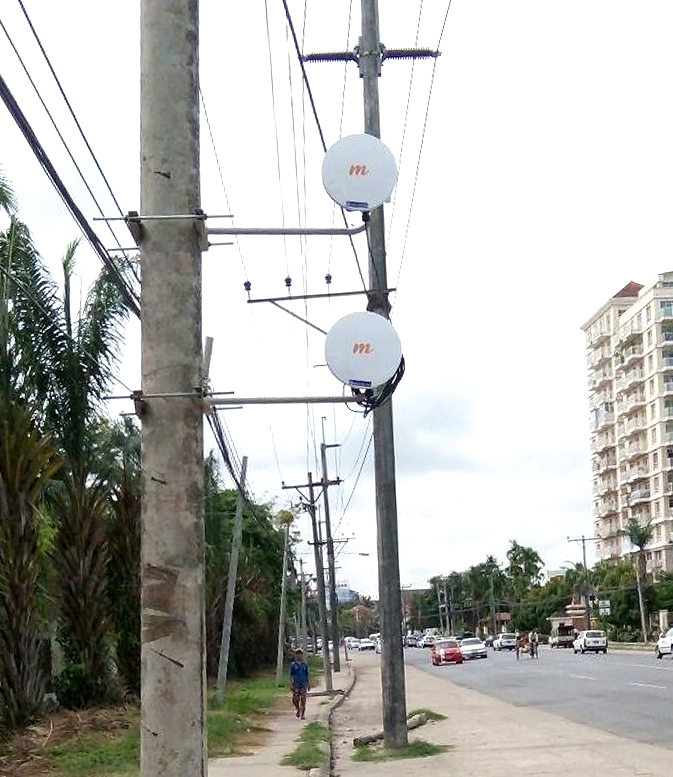Delivering fiber-like speeds with Mimosa's point-to-point and point-to-multipoint solutions.
Frontiir Deploys Mimosa Fixed Wireless to Provide Affordable Digital Access in Myanmar
Bridging the Global Digital Divide
When Frontiir opened their doors in 2012, internet services in Myanmar cost end users about $200/month for 4 Mbps. The networks at that time experienced frequent outages, peak-hour congestion, and accessibility issues.
Frontiir needed a solution that was cost-effective, noise-mitigating, reliable, and high-performance.
Frontiir solved its Myanmar Net congestion, co-channel interference, and link location constraints with the Mimosa B24 on account of its performance and functionality. Mimosa’s SRS (spectrum reuse synchronization, or GPS Sync) enables Frontiir to reuse spectrum for collocated B24’s. The compact size, weight and low power consumption were additional features that made the B24 the optimal solution.
Frontiir upgraded their backhauls to B24's, which easily addressed noise, spectrum, performance and reliability concerns. In turn, the savings were passed onto subscribers, allowing Frontiir to be competitive at $3.25/month for speed of up to 16 Mbps.
Frontiir’s mission to bridge the global digital divide is accomplished by maintaining high-performing networks built with high value products which enable them to offer their services at affordable prices in their market. To put this into perspective, the newly rolled out Myanmar Net targets a 10x price and performance advantage over comparable offerings in developed countries. This is based on estimates that the GDP of a typical frontier country like Myanmar is less than one-tenth that of a developed country.
Before getting a Mimosa upgrade, Myanmar Net used access points that required multiple low-capacity 5 GHz wireless hops to reach each fiber drop. Link installation options were often limited to rooftops, due to the bulk, weight, and wind load specs of competitor integrated radio antenna units. The other issue was that the 5 GHz spectrum was highly congested. This scenario, set in high-density urban environments where the wireless hops span short distances, caused co-channel interference. On top of that, congestion would build up quickly due to the first wireless hop from a fiber drop aggregating all traffic from the child nodes in each branch. These performance issues were hurting Frontiir’s price and performance target needed to offer affordable internet.
Frontiir solved its Myanmar Net congestion, co-channel interference, and link location constraints with the Mimosa B24 on account of its performance and functionality. Mimosa’s SRS (spectrum reuse synchronization, or GPS Sync) enables Frontiir to reuse spectrum for collocated B24’s. The compact size, weight and low power consumption were additional features that made the B24 the optimal solution.
“The B24 is an ideal solution to alleviate congestion and interference issues while keeping it lightweight, manageable, and power efficient.”
Allen Miu also added, “The B24 offers much better capacity than the 5 GHz channels and helps reduce co-channel interference, and improves spatial reuse by separating 5 GHz links with a B24 link operating at 24 GHz.” GPS synchronization is the technology that allows collocated B24 radios to share the same channel. Up to eight links can operate on a single rooftop operating at 1.5 Gbps. The B24 size and weight are smaller than alternatives allowing for easy installation in any setting. Myanmar Net was no longer forced to install links on rooftops. Their B24’s were installed on utility poles about every 60 meters which helped achieve the high-density coverage needed without the congestion. Power efficiency was another concern. since Myanmar Net has battery backup installed throughout its infrastructure to support the network during frequent power outages. B24’s were specifically designed to be battery-backup friendly, and only consume 19.5 W. Resilience in rain was another important factor, since Myanmar is located in the monsoon region of Asia. This is no problem for the B24, which offers superior
reliability, even in rain at practical distances up to 2 km, comparable to 60 GHz solutions.

Today, Myanmar Net achieves high-density coverage for a population of over 2.6 million in Myanmar’s two largest cities. Backhaul distribution is comprised of PTMP (point-to-multipoint), fiber and rooftop networks. Speed between links more than tripled, having run at 90 Mbps before adding the B24’s, to new high speeds of 300 Mbps. With the B24s in place, Myanmar Net was able to provide much improved broadband service to its customers and get back on track with its competitive price and performance target. Frontiir now offers its customers high-speed broadband services for $3.25/month for unlimited internet at speeds up to 16 Mbps.
About Frontier
Frontiir is a Myanmar-based wireless internet and information service provider founded in 2012. Their mission is to bridge the global digital divide by providing affordable digital access and information services to families and businesses in Myanmar.
When Frontiir opened their doors, internet services in Myanmar cost end users about $200/month for 4 Mbps. The networks at that time experienced frequent outages, peak-hour congestion, and accessibility issues. Frontiir rolled out its WiFi-based access network, named Myanmar Net, in 2015. The Myanmar Net services the nation’s two largest cities—their customer base is 80% residential and 20% commercial.
